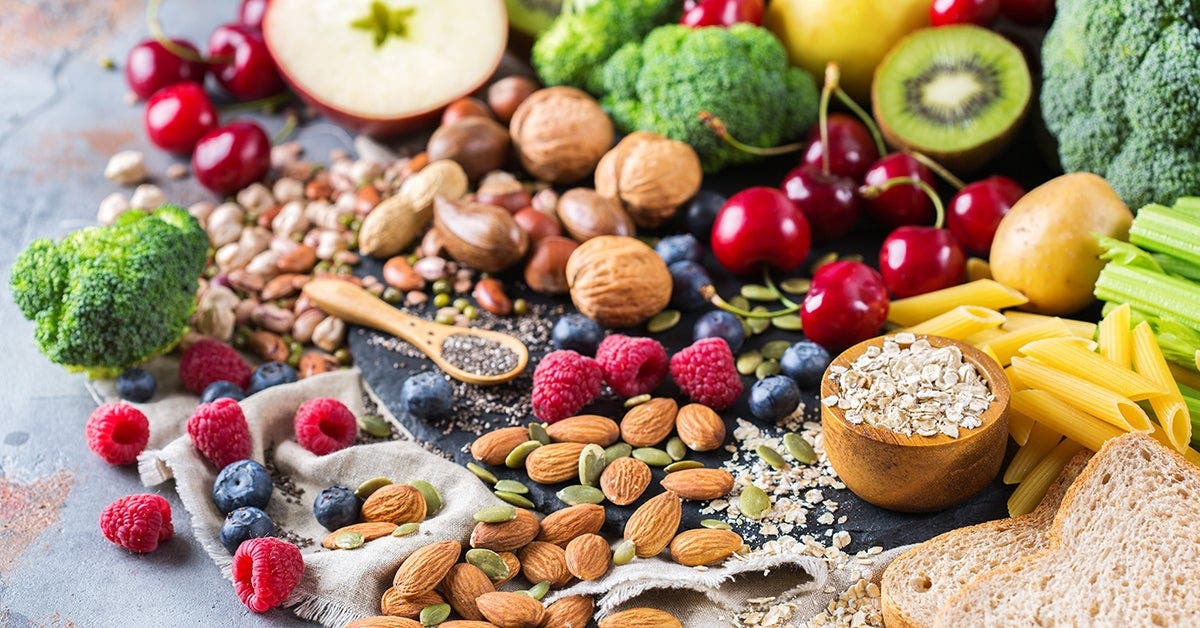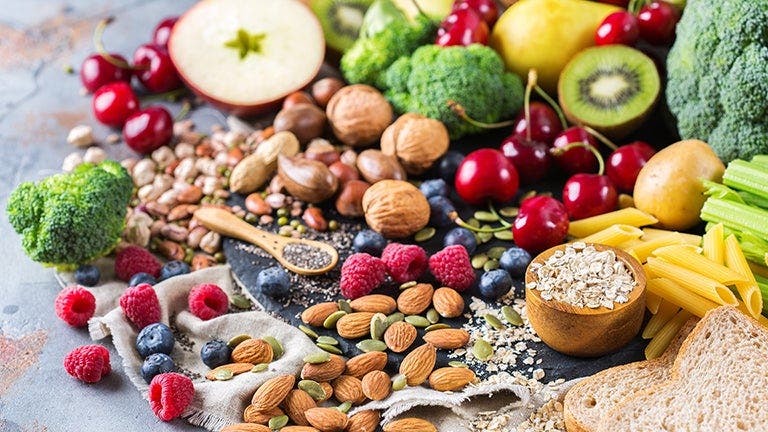5 reasons fiber deserves a starring role in your diet


With dour nicknames like “roughage” and “bulk,” fiber will probably never rank as a fun or trendy nutrient. “Few terms in the nutrition world sound less sexy,” says Lauren Slayton, R.D., founder of Foodtrainers in New York City, “but the benefits of fiber are about as valuable as you can get.” This humble dietary workhorse is definitely overdue for some love: In the latest Dietary Guidelines for Americans, fiber was named among the most underconsumed nutrients in the U.S., with many adults falling well short of getting the recommended 22–34 g of fiber per day. The exact amount you need depends on your age and sex, with the low end of the range is for women over the age of 50 and the high end is for men in their 20s. To see how you’re doing with that goal, check My Day in the WeightWatchers app. It will show you how much fiber you’ve had so far, as well as total calories, added sugar, carbs, protein, fat, and sodium. And all you have to do is track the foods you eat.
Ready to get excited about roughage? Read on to see how fiber can support your wellness journey, and discover simple, delicious ways to amp your intake.
What is fiber, exactly?
Fiber is a carbohydrate—one of three main classes. Only unlike its carby cousins (starches and sugars), fiber doesn’t provide glucose energy. Our bodies are unable to break down fiber for fuel, so we use it in other ways, explains Angel C. Planells, MS, a registered dietitian nutritionist in Seattle and a spokesperson for the Academy of Nutrition and Dietetics. Dietary fiber has a number of subtypes—for example, there’s pectin in pears and apples, inulin in onions, and cellulose in corn—which are classified as either soluble or insoluble depending on how they interact with water.
- Soluble fiber absorbs water in the digestive tract to form a gummy material. It’s found in cereal grains such as oats, as well as starchy vegetables, and pulses including beans, lentils, chickpeas, and peas.
- Insoluble fiber doesn’t react with water; it provides volume and bulk to stool and helps keep contents moving through the digestive tract. Insoluble fiber is found in whole grains, apples, nuts, beans, and nonstarchy vegetables.
Notice a trend in those food examples? Fiber occurs only in plants—think fruits, veggies, whole grains, seeds, nuts, and legumes. Unless it’s part of an added ingredient, you won’t find fiber in dairy, meat, poultry, seafood, or eggs. Typically, if a food is high in fiber, it contains both soluble and insoluble. Convenient!
Health benefits of fiber
No question: Fiber is pretty great for human health. Published research points to a slew of positive impacts associated with a fiber-rich diet. Here’s a look at some of the biggies:
1. Reduces risk of type 2 diabetes
Remember the fiber intake recommendations we mentioned at the start of this article? Large studies have shown that adults who consistently meet or exceed their daily targets are 20% to 30% less likely to develop type 2 diabetes over time. Researchers writing in The Journal of Nutrition in 2018 noted a number of possible reasons: For example, insoluble fiber may improve insulin sensitivity, a major risk factor for type 2 diabetes. Fiber can also be helpful for people already living with the condition, Planells notes. “Soluble fiber slows the absorption of glucose from food,” he says, echoing findings of the study cited above. “This can be helpful in regulating blood sugar levels.” Work with your doctor to develop a dietary game plan that makes sense for your medical needs.
2. Supports heart health
OK, this one isn’t exactly news. Health experts have long known about the association between high fiber intake and reduced incidences of coronary heart disease. One likely reason? A high-fiber diet can improve cholesterol numbers. Soluble fiber in particular appears to play a key role in decreasing levels of low-density lipoprotein (LDL) cholesterol—the harmful kind that builds up blood vessels. With a spongelike effect, the fiber soaks up excess LDL cholesterol in the gut and removes it from the body, helping to keep your arteries clear, Planells explains. What’s more, high fiber intake may support blood-pressure improvements in both healthy adults and those who are living with hypertension.
3. May lower cancer risk
Some evidence suggests that fiber-rich diets may help protect against certain types of cancer. Research has found that women who consumed the highest amounts of fiber were 8% less likely to develop breast cancer than those who consumed the least. The finding was consistent for women with both premenopausal and postmenopausal breast cancers.
Meanwhile, multiple studies have found that diets high in fiber—particularly the fiber found in fruit and whole cereal grains—are associated with a decreased likelihood of developing colon cancer. Fiber may promote cell turnover in that area of the large intestine, preventing cancer cells from proliferating, Slayton says.
4. Aids digestive function
Real talk: Does the word “fiber” automatically make you think of the poop emoji? Fair. Fiber is most famous for supporting laxation, better known as going number 2. In taking on water, soluble fiber helps form soft, bulky stools. Insoluble fiber adds further bulk and helps sweep waste material through the body’s plumbing.
But that’s not the only digestive trick up fiber’s sleeve. You know probiotics—the healthy bacteria that live in the gut? Well, those microbes need something to munch on. After passing through the upper part of the intestine undigested, fermentable fiber types (such as pectin and cellulose) become food for the probiotics that live in our gut, Slayton says. As probiotics chow down on the bounty, some produce short-chain fatty acids believed to play a role in immunity, inflammation control, and more. Other gut bacteria may use their fiber fill-up to influence appetite-related hormones. Says Slayton, “Just as we perform better when fed and nourished, the same can be said for probiotics.”
5. Supports healthy weight management
All signs point to fiber being helpful for long-term weight management. Research shows that the more fiber people eat, the less weight they gain and the less their waist circumference grows over time compared to people who consume less of the nutrient.
That’s not to say people who boost their fiber intake will magically lose weight, Planells clarifies. The weight effect is likely tied to fiber’s influence on our appetite and broader eating patterns: By filling us up and supporting a sustained release of energy from food, fiber may make us less likely to have seconds at mealtime, for example, or experience major munchies at bedtime.
How to eat more fiber
Boosting fiber intake comes down to a pretty simple practice: Putting plenty of plants on your plate each day, including fruits, vegetables, whole grains, and pulses. Slayton’s personal fiber-rich faves include:
- Lentils (8 g of fiber per ½ cup)
- Broccoli (2.4 g per cup)
- Cauliflower (2.1 g per cup)
- Sweet potato (2.8 g per medium potato, baked with skin)
- Cabbage (2.3 g per cup)
- Brussels sprouts (3.3 g per cup)
Tips for getting more fiber in your diet
- Leave tender skins on fruit and vegetables and eat the items whole. Outer peels often contain a concentration of fiber, Slayton says.
- Mix up your pasta game by making dishes with alternanoodles high in fiber—think minty pea pasta with chickpea rotini, or beefy Bolognese with lentil-based noodle.
- Try grain-rich recipes that incorporate bulgur, barley, quinoa, farro, wild rice, buckwheat, or millet. And when shopping for grains, pasta, or other packaged products, be sure to read Nutrition Facts panels for details on the fiber content.
- Make a batch of fiber-rich trail mix, tossing together whole-grain cereal, dried fruit, and nuts. Portion out servings to stash in your glove compartment, desk drawer, or tote bag.
- Instead of sour cream, try using veggies to make a flavorful snack dip. Options such as white beans, roasted eggplant, and sweet red peppers make delicious bases for dunking.
- Sub in bran cereal or rolled oats for traditional breadcrumbs in meatloaf.
- Sprinkle toasted nuts and seeds onto salads.
High-fiber foods vs. fiber supplements
Fiber nutrition supplements may be helpful for some people when their diets fall short. Still, those capsules and powdered drink mixes aren’t a perfect replacement for whole foods. “When I consume a piece of fruit, I get not just the fiber, but the vitamins, minerals, antioxidants, and the fluid that come with the fruit,” Planells says. “If I take the supplement, I only get fiber.” If you think you might benefit from a fiber supplement, chat with your doctor.
The bottom line
Fiber is a carbohydrate found in many plant-based foods, including fruits, veggies and whole grains. Eating plenty of fiber can help you reduce the risk for serious health conditions like type 2 diabetes, improve your heart health by lowering cholesterol, and keep your digestive system happy. Fiber may also help you maintain a healthy weight since it can help keep you feeling full. While most adults should get between 22 and 38 grams of fiber a day, many fall short. Check My Day in the WeightWatchers app to see how much fiber you eat in a day.
This content is for informational purposes only and does not constitute medical advice, diagnosis or treatment. It should not be regarded as a substitute for guidance from your healthcare provider.
Overall view on fiber: Journal of the Academy of Nutrition and Dietetics (2015). “Position of the Academy of Nutrition and Dietetics on Dietary Fiber.”
https://www.jandonline.org/article/S2212-2672(15)01386-6/abstract
https://www.dietaryguidelines.gov/sites/default/files/2021-03/Dietary_Guidelines_for_Americans-2020-2025.pdf
